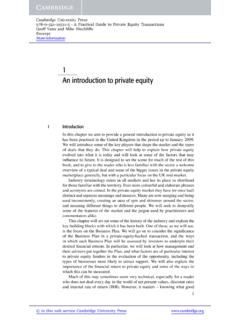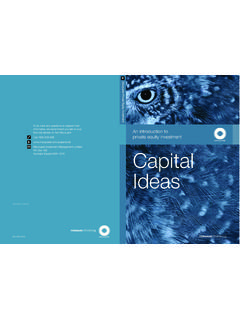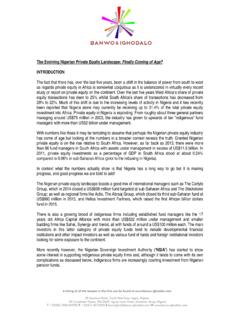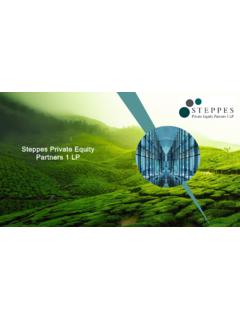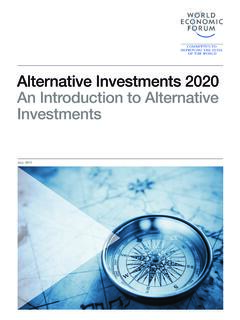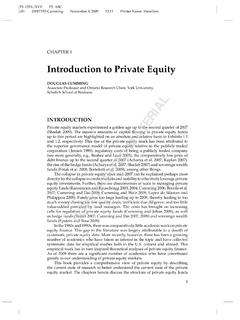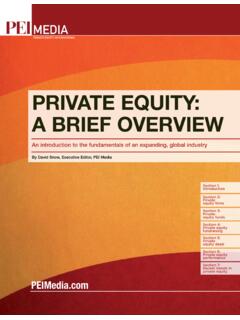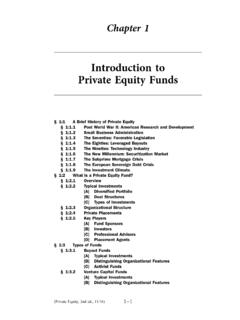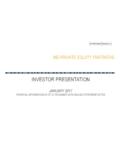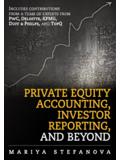Transcription of Introduction to Investment Funds - Deloitte US
1 Introduction to Investment FundsLink nLearn 16 June 2016 Link nLearn 2016 SpeakerTomRendersSeniorManager,AuditDelo itteBelgiumTel:+32 2 800 20 principles2 Regulatory evolutions3 Market trends4 How an Investment Funds works? Different structures Parties involvedIntroduction The asset management industry plays a distinctive role in capital markets by pooling the savings of investors and investing them strategically in financial instruments and other assets with the aim of generating returns. Asset Management IndustryEconomic function of asset management industry:Facilitate participation of small investors in financial markets (and sometimes offering a form of capital protection)Participate in both primary and secondary equity marketsProviding short and long term credit to corporates, financials institutions and governmentsParticipate in price discoveryAsset managers interact with banks and insurers in different ways.
2 Through commissions for managing their portfoliosPresence in banking groups and corporate ownershipsSourcing of leverage through prime-brokerage agreementsDistribution agreementsRole of Investment Funds in the Asset Management industryIntroductionInvestorsInsurance companiesPension FundsHNWIH ouseholdsBanksOtherRetailInstitutionalDi scretionary MandatePrivate BankerInvestment management companyInvestment fundManCoFund AdministratorDepositary BankInvestInvestGeneral principlesHow Investment Funds work?Key principlesMain principle: many small investors make one large investorDiversified portfoliosLess risk (sometimes capital protected)Professional expertise (but costs are charged)Access to foreign markets (which might be blocked for private investors)Many types of mutual fundsFlowchartInvestment FundDividends/ InterestMarket Prices of SecuritiesFund ManagerValue of fund UnitsShares/ UnitsMoneyInvestorsTerminology Net Asset Value (NAV).
3 Intrinsic value of fund Usually expressed per share outstandingAssetsInvestmentsCash at BankDebtorsLiabilitiesCreditorsTotal Net AssetsNumber of shares outstandingNAV per share1,00020050301,22010012,2 Importance of the NAV:All open-ended Investment Funds must stand ready to redeem shares upon demand by the shareholder. The fund may also want to accept new capital. In order to complete either of these transactions without disadvantaging either the existing shareholders (be they continuing or cashing out) or the new shareholders, the NAV per share must be calculated.
4 Terminology Prospectus:Contract between investor and mutual fundPublicly availableDetermines: Parties involved Investment strategy of the compartment Fee structureKey Investor Information Document (KIID):A stand-alone, pre-contractual, 2-page document containing the essential features of the fund and is to be systematically provided to investors before they decide to investDifferent structuresDifferent structuresMany distinctions are possible between types of Investment Funds , based on:Legal criteria Mainly dependent of country of originOrganisational criteria fund of Funds , Master/Feeder, closed ended Funds .
5 Regulatory regimes UCITS, AIFMDI nvestment policy We refer to the next slides for further detailsRisk and reward potential for types of fundsThree basic types can be identified: stock (also called equity ), bond and money marketDepending of the underlying investments of the fund , the risk and reward profile will also be different (at least in theory)Lower Risk and ReturnMoney Market FundsShort and Intermediate-term Bond FundsLong-term Bond FundsBalanced FundsMedium Risk and ReturnHigh Risk and ReturnGrowth and Income Stock FundsGrowth Stock FundsAggressive Growth Stock FundsParties involvedParties involvedInvestorsInvestment ManagersPrime Broker/CustodianFundTransfer AgentRegulatorAdministratorBoard of DirectorsHolds Cash & InvestmentsRegular ReportingRegular ReportingGovernance and oversightReporting/ Financial StatementsCalculates NAVM aintains Shareholder
6 RegisterManages Subs & RedsAML/ CommunicationsSubscribe/ RedeemExecutes tradesEarns feesManages fundsSales/ RelationshipRoles of key participantsRegulatorAuthorisationSuperv isionTo ensure the safe-keeping of investmentsEnsures that the sale and the purchase of shares is made in accordance with the Investment policyExecute the requests of the management company or the management of the fund in relation to the aboveCustodianPrime BrokerThe services provided under prime brokering are securities lending, leveraged trade execution, and cash managementGlobal custodyRoles of key participantsResponsible for establishing the fundOften located in fund centres such as London and New YorkVary in size from boutique firms to global playersMarkets the fund to investors (often works with distributors to market Funds across multiple jurisdictions)Manages portfolio of investments and makes Investment decisions (portfolio management may be undertaken by a separate Investment advisor)
7 Investment ManagerCalculation of Net Asset Value (NAV).Maintaining and updating the portfolio of investmentsPricing of assetsCalculating fees and expensesPreparing interim and annual accountsAdministratorRoles of key participantsProcesses subscriptions and redemptions including the collection and payment of cashCompletes Know Your Client (KYC) and Anti-Money Laundering (AML) proceduresMaintains shareholder registerManages shareholder communicationsProcesses dividends/distributionsTransfer AgentUltimate responsibility for the governance of the fund and for safeguarding the interests of investorsAlso responsible for approving the fund documents, the financial statements and the appointment of the service providersBoard of DirectorsRegulatory evolutionsOur understanding of current challengesIt s relatively easy to identify the challenges facing Funds .
8 But it s a lot harder to determine how an individual fund should respond. Understanding these challenges as external auditor hereby forms an integral part in carrying out a risk-oriented and client-tailored audit Financing Transaction Regulation (SFTR)Q1 2016: entry into forceQ3 2016: start of the phased-in implementationTo be confirmed by ESMA and European CommissionEuropean Market and Infrastructure Regulation (EMIR)21 June 2016: Clearing obligations start for certain types of interest rate derivativesQ3 2016: Start exchange of initial and variation margins for non-centrally-cleared OTC derivativesTo be confirmed by ESMA and European CommissionMiFIR/MiFIDMiFIR/MiFID: Final delegated regulation and delegated directive2016201791324567810111239124567 8101112 UCITS VUCITS V: ImplementationCRSCRS: Go-live of new on-boarding packages related to CRS classification / Go-live of data captureEMIREMIR: Clearing obligations for certain type of interest rate derivativesEMIR"EMIR.
9 Exchange of initial and variation margins for non-centrally-cleared OTC derivativesSTFRSFTR: Phased-in implementationPRIIPSPRIIPS: Entry intro force and new KIDSCRSCRS: First exchange of data with Luxembourg tax authoritiesSecurities Financing Transaction Regulation (SFTR)January 2016 - Receipt of feedback on the draft RTSM arch 2016 - The ESA will deliver the draft RTS to the ECDecember 2016 Entry into force of the Regulation New KIDs are requiredDecember 2019 End of the grandfathering period for UCITSUCITS VMarch 2016 at the latest.
10 Implementation of the Directive Our understanding of current challengesCommon Reporting Standard (CRS)New on -boarding packages (subscription forms) regarding CRS classification of both entities and individuals must go live on 1 January 2016 Contractual documentation such as general terms of business and prospectuses should be updated before 1 January 2016 Data capture for CRS purposes (tracking financial data) should go live on 1 January 2016 Classification and remediation of pre-existing clients (c)










